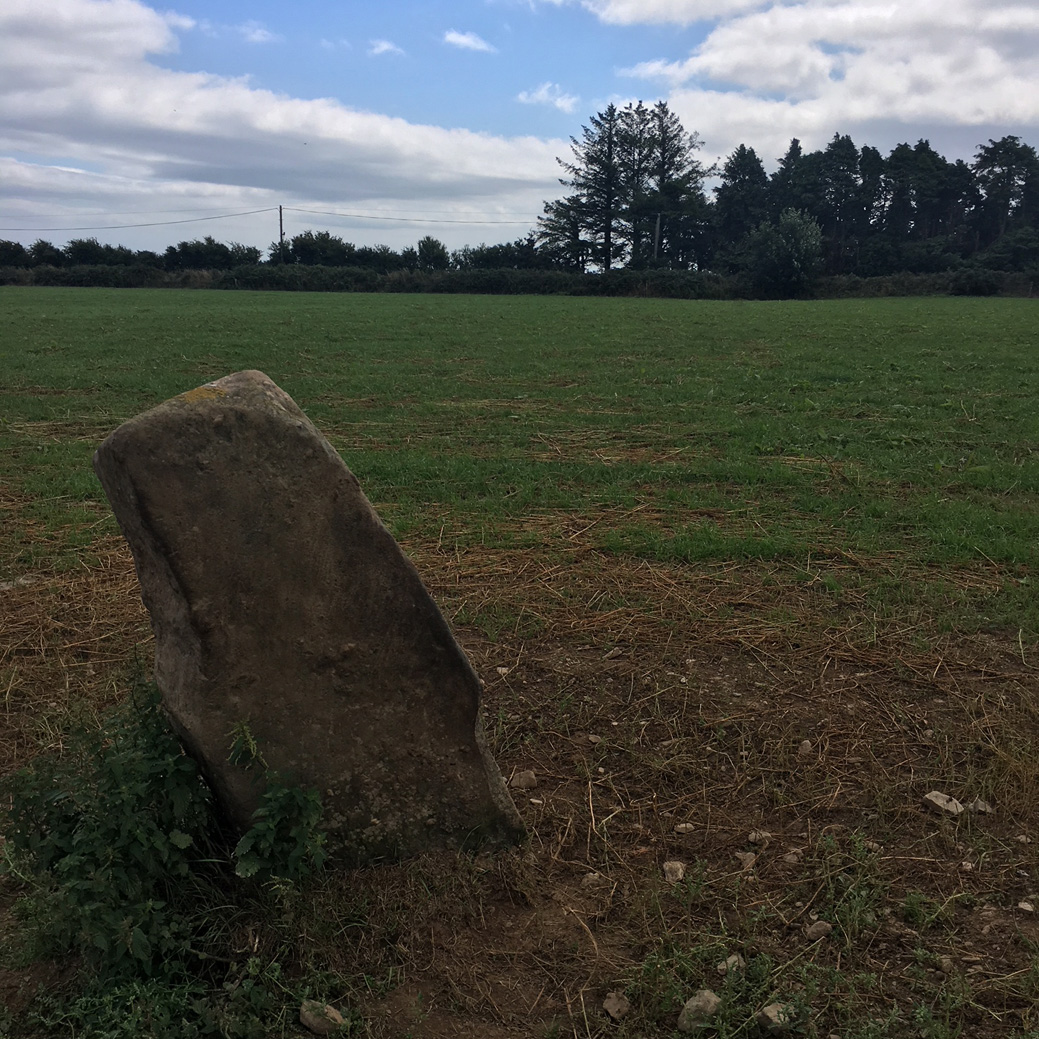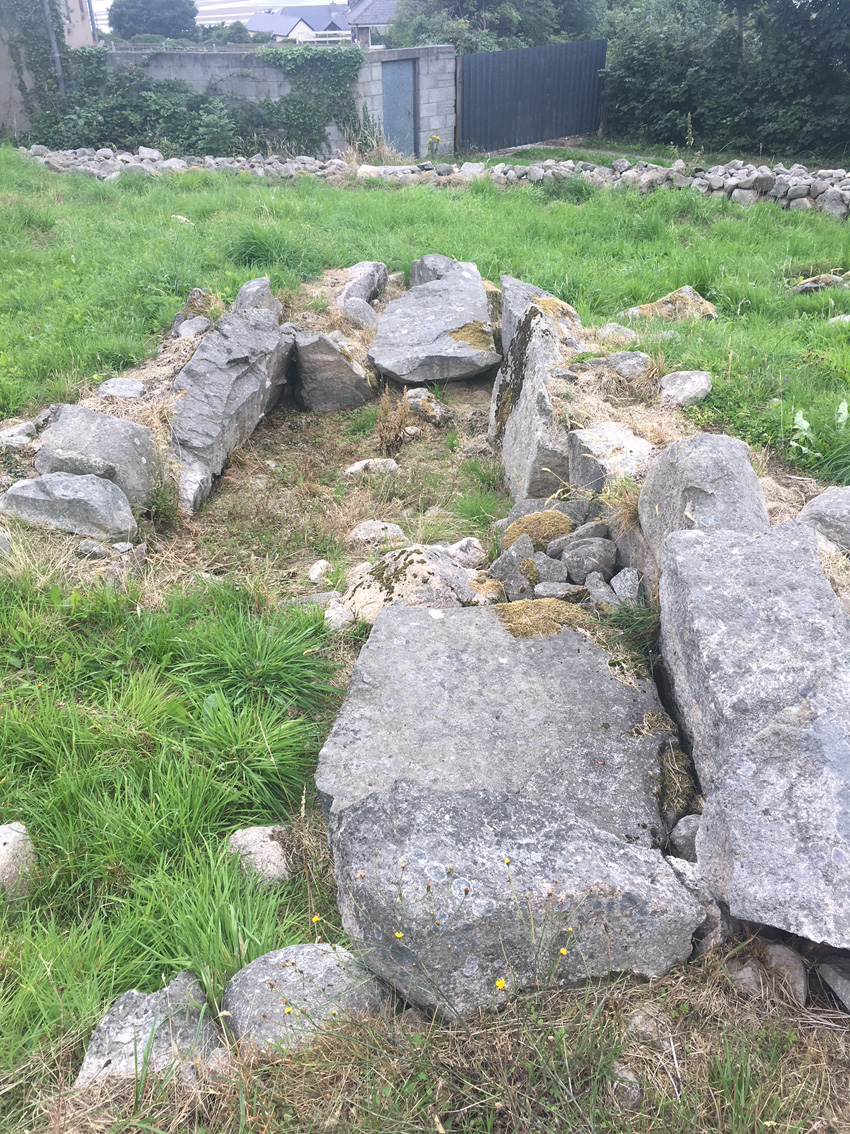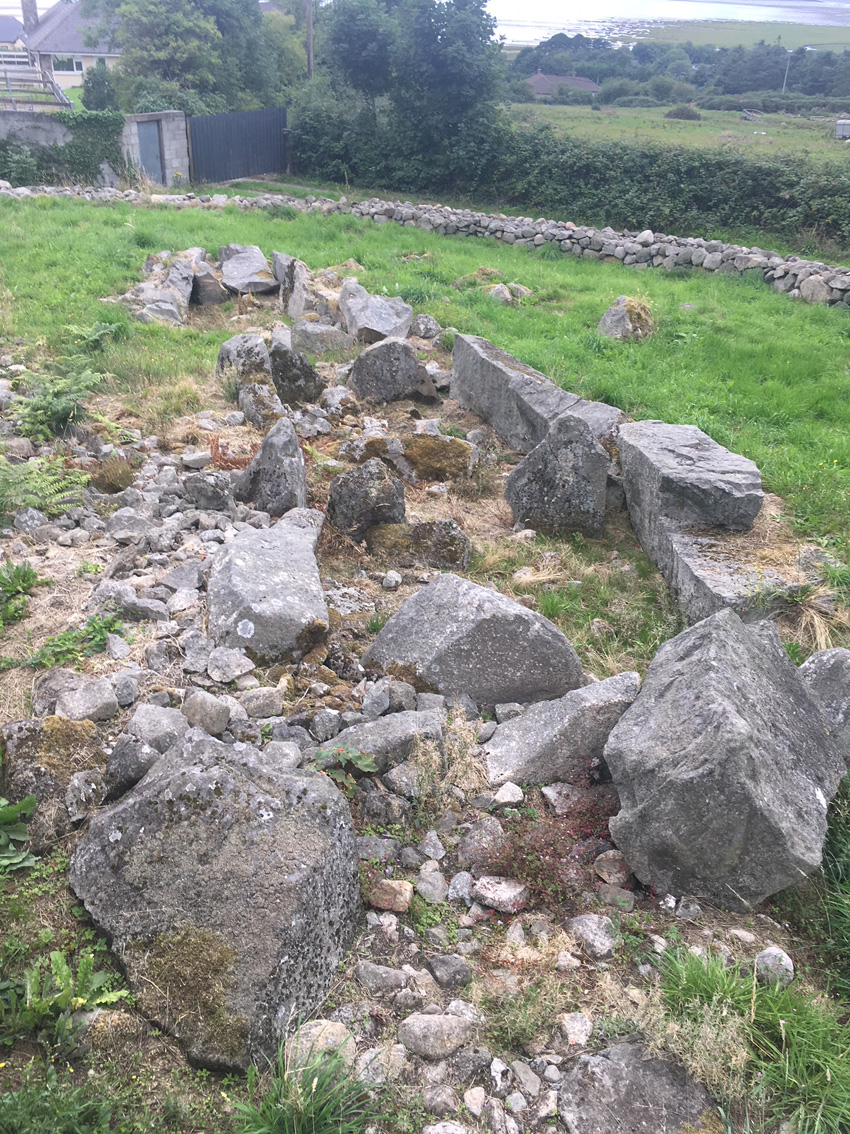



A capstone and a sidestone are all that remains at Dunhill. It’s still pretty cool though.
From archaeology.ie:
Description: Situated in pasture on a fairly steep SE-facing slope of the N-S valley of the Annestown stream, which is c. 210m to the E. The roofstone (dims. 4m x 2.7m; T 1.2m) is supported by one orthostat. (Atkins 1896, 71-2; Borlase 1897, vol. 1, 57; Ó Nualláin 1983, 103)
The above description is derived from the published ‘Archaeological Inventory of County Waterford’ (Dublin: Stationery Office, 1999). In certain instances the entries have been revised and updated in the light of recent research.
Compiled by: Michael Moore.
Date of upload/revision: 16th May 2011.
References:
1. Atkins, R. 1896 The rude stone monuments of our own and other lands. Waterford and South East of Ireland Archaeological Journal 2, 60-80, 131-61.
2. Borlase, W.C. 1897 The Dolmens of Ireland, 3 vols. London. Chapman and Hall, London.
3. Ó Nualláin, S. 1983 Irish portal tombs, topography, siting and distribution. Journal of the Royal Society of Antiquaries of Ireland 113, 75-105.




The portals are missing and the capstone rests on the doorstone.
From archaeology.ie:
Description: Situated in pasture on a broad plateau with a slight E-facing slope. An oval roofstone (dims. 4m x 2.65m; T 0.7m) is resting on the septal-slab and the backstone with a cushion-stone between the roofstone and the backstone. The tomb, which faces SW, lacks portal-stones but the sidestones are present. It was investigated and conserved in 1939-40 when cremated bone, flint and charcoal were found in the chamber (Herity 1964). (Du Noyer 1864-6, 480; Atkins 1896, 68-9; Ó Nualláin 1983, 103; Harbison 1992, 325)
The above description is derived from the published ‘Archaeological Inventory of County Waterford’ (Dublin: Stationery Office, 1999). In certain instances the entries have been revised and updated in the light of recent research.
Compiled by: Michael Moore.
Date of upload/revision: 13th May 2011.
This monument is subject to a preservation order made under the National Monuments Acts 1930 to 2014 (PO no. 63/1938).
References:
1. Atkins, R. 1896 The rude stone monuments of our own and other lands. Waterford and South East of Ireland Archaeological Journal 2, 60-80, 131-61.
2. Du Noyer, G.V. 1864-6 On cromleacs near Tramore in the County of Waterford; with remarks on the classification of ancient Irish earthen and megalithic structures. Journal of the Royal Society of Antiquaries of Ireland 8, 474-82.
3. Harbison, P. 1992 Guide to the national and historic monuments of Ireland. Gill and Macmillan Ltd., Dublin.
4. Herity, M. 1964 The finds from the Irish portal dolmens. Journal of the Royal Society of Antiquaries of Ireland 94, pt. 2, 123-44.
5. Ó Nualláin, S. 1983 Irish portal tombs, topography, siting and distribution. Journal of the Royal Society of Antiquaries of Ireland 113, 75-105.



Conservation kinda worked here. I guess it’s better than Savagetown up the road, but only just.

The capstone rests on a portal stone and whatever else is back there. The tomb is not visible on the other side of the bank/fence.


The first glimpse as you approach from the west is not very promising.
From archaeology.ie:
Description: Located on a shelf on a gentle W-facing slope, and facing E (upslope). The roofstone (L 3.4m; T 0.6m) is resting on a portal-stone and the S sidestone. The backstone is present but the rest of the tomb is obscured by a field bank. (Ó Nualláin 1983, 103)
The above description is derived from the published ‘Archaeological Inventory of County Waterford’ (Dublin: Stationery Office, 1999). In certain instances the entries have been revised and updated in the light of recent research.

Like a fallen gravestone, but actually an earthfast boulder.

The bullauns are not the deepest but are still pretty cool.


There are ancient field systems and an ancient trackway near the stone.


Thinner profile, aligned north-east/south-west.

About 1.3 metres tall, though leaning to the north.

The Monavullagh mountains are north-west of the stone.

Monavullagh mountains in the distance

Looking along the full length of the two galleries from the north.



Looking north from the smaller chamber/gallery. I thought the cracked stone visible here is the backstone of a south facing chamber and that this is a dual court tomb. However, there is no trace of a court at the south so maybe this is a segmented court tomb, with the northern gallery split into two chambers by jamb stones and the lower southern gallery with just the single chamber.

Another north-south view. Much remains of the tomb but it is still fairly wrecked.

The entrance has been interfered with but the segmentation of the different chambers is clear looking along the gallery from the north.



Much cairn material remains and the large stones here may be gallery roofstones.

It’s hard to make out whether these are court stones or part of the entrance facade.
The following description is derived from both the published ‘Archaeological Inventory of County Louth’ (Dublin: Stationery Office, 1986) and the ‘Archaeological Survey of County Louth’ (Dublin: Stationery Office, 1991). In certain instances the entries have been revised and updated in the light of recent research.
Date of upload/revision: 17 July 2007
This court-tomb is incorporated in a roughly trapezoidal cairn some 30m long and 20m wide at the WSW, narrowing to 7.1m wide at the ESE. There is a well-defined court at the W leading to the gallery area which is covered by cairn material. The court, 7.5m wide and 6m deep, embraces almost three-quarters of a circle and is represented by 14 orthostats, 7 at either side. Two large slabs lie at the inner end of the court. A single façade stone stands beyond the N arm of the court. Two kerb stones are exposed at the E end of the cairn and a field wall runs along its southern side. (PRIA (C) 1960, 128-9)

Looking into the court. I believe that there have been changes here since the inventory (see below) were here in 1960.

There is much cairn material left but no visible gallery or chambers.


Standing on the wall looking down on the entrance jambs to the north-east gallery.


Looking along the two chambers of the north-east gallery towards where the now non-existent court would have been.



Not much to see here. I reckon it would have been removed long ago only for superstition.


Taken from the credited book.
In the folk tradition it is the burial place of a Scandinavian giant called Manowar, who came here to kill Fin McCool. Fearing the foreign visitor, Fin had himself disguised as a baby by his wife and bit Manowar on the finger when the latter attempted to tease him. As this was just the baby Manowar became afraid and attempted to leave but dropped dead mysteriously afterwards.
(Flanagan 1933; IFC, Schools MSS, (931)
Tests show 5,000-year-old remains found at the world heritage site came from more than 100 miles away in west Wales
Maev Kennedy
The bones of people buried at Stonehenge, who died and were cremated about 5,000 years ago, have given up their secrets: like the bluestones, which form part of the famous prehistoric monument, they came from west Wales, near the Preseli Hills where the stones were quarried.
The remains of at least 10 of 25 individuals, whose brittle charred bones were buried at the monument, showed that they did not spend their lives on the Wessex chalk downland, but came from more than 100 miles away. Examination of the remains showed they were consistent with a region that includes west Wales, the most likely origin of at least some of these people.
Although the team, led by scientists from the University of Oxford with colleagues in Paris and Brussels, cannot prove that the remains are of people who actually built the monument, the earliest cremation dates are described as “tantalisingly” close to the date when the bluestones were brought into the earlier ditch and bank monument to form the first stone circle.
More:
theguardian.com/science/2018/aug/02/revealed-stonehenge-buried-welsh?CMP=Share_iOSApp_Other

Found in the field that contains the tombs – see link below for the story. Now in the National Museum of Ireland.
The Gleninsheen Gold Collar, a Bronze Age Treasure
By Colm on April 23, 2015 in Archaeology blogs, Irish treasures